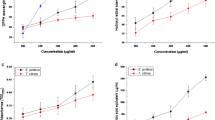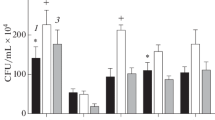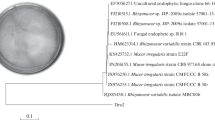Abstract
From ancient times, plants and plant derived products are exploited as a prominent source of folkloric medicines with tremendous therapeutic potential for an array of health disorders. In the present study, ethanolic leaf extract of Hibiscus sabdariffa and Croton caudatus were evaluated for free radical scavenging activity in Saccharomyces cerevisiae model system. H. sabdariffa and C. caudatus showed tremendous DPPH free radical scavenging potential with an IC50 value of 184.88 and 305.39 µg/mL respectively at a concentration of 500 µg/mL. The ethanolic leaf extract of H. sabdariffa and C. caudatus also showed significant hydoxyl radical scavenging and total antioxidant activity. Ascorbic acid was used as positive control. The in vitro antioxidant activity was further supported by in vivo studies using radical scavenging mechanism in S. cerevisiae wild type and its isogenic deletion strains sod1∆ and tsa1∆. The mutant yeast cells substantially scavenged the stress generated by H2O2 when supplemented with ethanolic leaf extract of H. sabdariffa and C. caudatus as evident from spot assays followed by fluorescence assay (DCF-DA) using fluorescence microscopic and intensity studies. H. sabdariffa and C.caudatus significantly neutralize the ROS level in yeast mutants with concomitant decrease in fluorescence intensity as compared to the untreated yeast cells. The results suggested the efficacy of H. sabdariffa and C. caudatus as potent antioxidants in yeast system and thus their futuristic applications in therapeutics.



Similar content being viewed by others
References
Aderogba MA, McGaw LJ, Bezabih M, Agebaz BM (2011) Isolation and characterization of novel antioxidant constituents of Croton zambesicus leaf extract. Nat Prod Res 25(13):1224–1233
Aqil F, Gupta A, Munagala R, Jeyabalan J, Kausar H, Sharma R, Singh IP, Gupta RC (2012) Antioxidant and antiproliferative activities of anthocyanin/ellagitannin-enriched extracts from Syzygium cumini L. (Jamun, the Indian Blackberry). Nutr Cancer 64(3):428–438
Azad GK, Singh V, Tomar RS (2014) Assessment of the biological pathways targeted by isocyanate using N-Succinimidyl N-methylcarbamate in budding yeast Saccharomyces cerevisiae. PLoS ONE 9(3):e92993
Benharlal PS, Arumughan C (2007) Chemical composition and in vitro antioxidant studies on Syzigium cumini fruit. J Sci Food Agr 87:2560–2569
De Almeida TS, Rocha JBT, Rodrigues FFG, Campos AR, Da Costa JGM (2013) Chemical composition, antibacterial and antibiotic modulatory effect of Croton campestris essential oils. Indust Crops Prod 44:630–633
Eshwarappa RSB, Iyer RS, Subbaramaiah SR, Richard SA, Dhanajaya BL (2014) Antioxidant activity of Syzigium cumini leaf gall extracts. Bioimpacts 4(2):101–107
Falowo AB, Muchenje V, Hugo A, Aiyegoro OA, Fayemi PO (2016) Antioxidant activities of Moringa oleifera L. and Bidens pilosa L. leaf extracts and their effects on oxidative stability of ground raw beef during refrigeration storage. CYTA J Food 15(2):1–8
Formagio ASN, Ramos DD, Vieira MC, Ramalho SR, Silva MM, Zarate NAH, Foglio MA, Carvalho JE (2015) Phenolic compounds of Hibiscus sabdariffa and influence of organic residues on its antioxidant and antitumoral properties. Braz J Biol 75(1):69–76
Frassinetti S, Croce CMD, Caltavuturo L, Longo V (2012) Antimutagenic and antioxidant activity of Lisosan G in Saccharomyces cerevisiae. Food Chem 135:2029–2034
Golla U, Raj Bhimathati SS (2014) Evaluation of antioxidant and DNA damage protection activity of the hydroalcoholic extract of Desmostachya bipinnata L. Stapf. Sci World J 2014: Article ID: 215084
Huang C, Song P, Fan P, Hou C, Thacker P, Ma X (2015) Dietary sodium butyrate decreases postweaning diarrhea by modulating intestinal permeability and changing the bacterial communities in weaned piglets. J Nutr 145(12):2774–2780
Islam S, Nasrin S, Khan MA, Hossain ASMS, Islam F, Khandokhar P, Mollah MNH, Rashid M, Sadik G, Rahman MAA, Alam AHMK (2013) Evaluation of antioxidant and anticancer properties of the seed extracts of Syzigium fruticosum Roxb. Growing in Rajshahi, Bangladesh. BMC Compl Altern Med 13:142–151
Kalaivani T, Rajasekaran C, Suthindhiran K, Mathew L (2011) Free radical scavenging, cytotoxic and hemolytic activities from leaves of Acacia nilotica (L.) wild ex. Delile subsp. indica (Benth.) Brenan. Evid Compl Altern Med 2011:Article ID:274741
Kerdsomboon K, Tatip S, Kosasih S, Auesukaree C (2015) Soluble Moringa oleifera leaf extract reduces intracellular cadmium accumulation and oxidative stress in Saccharomyces cerevisiae. J Biosci Bioeng 21(5):543–549
Mohamed AA, Ali SI, El-Baz FK (2013) Antioxidant and antibacterial activities of crude extracts and essential oils of Syzigium cumini leaves. PLoS ONE 8(4):e60269
Mohd-Esa N, Hern FS, Ismail A, Yee CL (2010) Antioxidant activity in different parts of roselle (Hibiscus sabdariffa L.) extracts and potential exploitation of the seeds. Food Chem 122:1055–1060
Nath R, Roy S, De B, Choudhury MD (2013) Anticancer and antioxidant activity of Croton: a review. Int J Pharm Pharmaceut Sci 5(2):63–70
Pejin B, Savic A, Sokovic M, Glamoclija J, Ciric A, Nikolic M, Radotic K, Mojovic M (2014) Further in vitro evaluation of antiradical and antimicrobial activities of phytol. Nat Prod Res 28(6):372–376
Qaisar MN, Chaudary BA, Uzair M, Hussain SN (2013) Evaluation of antioxidant and cytotoxic capacity of Croton bonplandianum. Baill. Am J Plant Sci 4:1709–1712
RosangkimaG Jagetia GC (2015) Anticancer, antioxidant and analgesic properties of Croton caudatus Geisel leaf extracts. Int J Curr Res 7(9):20640–20646
Saeed N, Khan MR, Shabbir M (2012) Antioxidant activity, total phenolic and total flavonoid contents of whole plant extracts Torilis leptophylla L. BMC Compl Altern Med 12:221–232
Santos CCMP, Salvadori MS, Mota VG, Costa LM, de Almeida AAC, de Oliveira GAL, Costa JP, de Sousa DP, de Freitas RM, de Almeida RN (2013) Antinociceptive and antioxidant activities of phytol in vivo and in vitro models. Neurosci J 2013:Article ID: 949452
Shah AA, Khan MS, Khan S, Ahmad N, Alhidary IA, Khan RU, Shao T (2016) Effect of different levels of alpha tocopherol on performance traits, serum antioxidant enzymes, and trace elements in Japanese quail (Coturnix coturnix japonica) under low ambient temperature. Revista Brasileira de Zootecnia 45(10):622–626
Sharma K, Pasricha V, Satpathy G, Gupta RK (2015) Evaluation of phytochemical and antioxidant activity of raw Pyrus communis (l), an under exploited fruit. J Pharmacognosy Phytochem 3(5):46–50
Shibula K, Velavan S (2015) Determination of phytocomponents in methanolic extract of Annona muricata leaf using GC-MS technique. Int J Pharmacognosy Phytochem Res 7(6):1251–1255
Silva RO, Sousa FBM, Damasceno SRB, Carvalho NS, Silva VG, Oliveira FRMA, Sousa DP, Aragao KS, Barbosa ALR, Freitas RM, Medeiros JVR (2013) Phytol, a diterpene alcohol, inhibits the inflammatory response by reducing cytokine production and oxidative stress. Fund Clin Pharmacol 28(4):455–464
Slatnar A, Jakopic J, Stampar F, Veberic R, Jamnik P (2012) The effect of bioactive compounds on in vitro and in vivo antioxidant activity of different berry juices. PLoS ONE 7(10):e47880
Sudha TC, Mohan VR (2013) GC-MS Analysis of Bioactive Components of Aerial parts of Fluggea leucopyrus Willd. (Euphorbiaceae). J Appl Pharmceut Sci 3(5):126–130
Tahir HE, Xiaobo Z, Jiyong S, Mariod AA, Wiliam T (2016) Rapid determination of antioxidant compounds and antioxidant activity of Sudanese Karkade (Hibiscus sabdariffa L.) using near infrared spectroscopy. Food Anal Method 9:1228–1236
Tounkara F, Bashari M, Le GW, Shi YH (2014) Antioxidant activities of Roselle (Hibiscus sabdariffa L.) seed protein hydrolysate and its derived peptide fractions. Int J Food Prop 17(9):1998–2011
Vargas FS, Soares DG, Ribeiro APD, Hebling J, Costa CA (2014) Protective effect of alpha-tocopherol isomer from vitamin E against the H2O2 induced toxicity on dental pulp cells. Biomed Res Int 2014:Article ID:895049
Wang J, Cao X, Jiang H, Qi Y, Chin KL, Yue Y (2014) Antioxidant activity of leaf extracts from different Hibiscus sabdariffa accessions and simultaneous determination five major antioxidant compounds by LC-Q-TOF-MS. Molecules 19:21226–21238
Wu CY, Steffen J, Eide DJ (2009) Cytosolic Superoxide Dismutase (SOD1) is critical for tolerating the oxidative stress of zinc deficiency in yeast. PLoS ONE 4(9):e7061
Wu MJ, O’Doherty PJ, Fernandez HR, Lyons V, Rogers PJ, Dawes IW, Higgins VJ (2011) An antioxidant screening assay based on oxidant-induced growth arrest in Saccharomyces cerevisiae. FEMS Yeast Res 11:379–387
Yin G, Cao L, Xu P, Jeney G, Nakao M (2011) Hepatoprotective and antioxidant effects of Hibiscus sabdariffa extract against carbon tetrachloride-induced hepatocyte damage in Cyprinus carpio. Vitro Anim Cell Dev Biol 47:10–15
Zhang Y, Chen J, Wang L, Cao J, Xu L (2016) Chemical composition and biological activities of the essential oil from Rubus pungens var. oldhamii. Nat Prod Res 6:1–5
Zou G, Su ZH, Zhang HW, Wang Y, Yang J, Zou ZM (2010) Flavonoids from the stems of Croton caudatus Geisel. var. tomentosus Hook. Molecules 15:1097–1102
Author information
Authors and Affiliations
Corresponding author
Ethics declarations
Conflict of interest
The authors are declaring no conflict of interests in this work.
Rights and permissions
About this article
Cite this article
Subhaswaraj, P., Sowmya, M., Bhavana, V. et al. Determination of antioxidant activity of Hibiscus sabdariffa and Croton caudatus in Saccharomyces cerevisiae model system. J Food Sci Technol 54, 2728–2736 (2017). https://doi.org/10.1007/s13197-017-2709-2
Revised:
Accepted:
Published:
Issue Date:
DOI: https://doi.org/10.1007/s13197-017-2709-2




